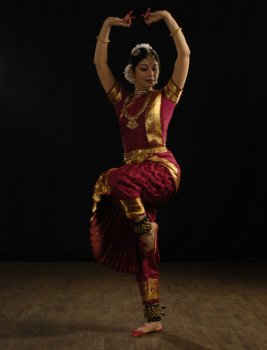
|   |

|   |
Devi: Priya Venkataramanís theme based recital - Dr. Sunil Kothari e-mail: sunilkothari1933@gmail.com October 26, 2012 On October 20 during the Navaratri celebrations, it was a most appropriate theme that Priya Venkataraman, a disciple of A. Lakshman, chose to present in a one hour solo Bharatanatyam recital at Azad Bhavan Auditorium of Indian Council for Cultural Relations (ICCR), Delhi. Dr. Suresh Goel, the Director General of ICCR, was the chief guest and a large number of leading local dancers and cognoscenti were present. The performance was supported by ICCR, Ministry of Culture, Govt. of India. Attired in an aesthetic orange colour costume, with a tall, svelte figure, long arms and a commanding stage presence, Priya evoked images of the Goddess in her various manifestations. Without Shakti, Shiva is incomplete, the feminine energy Prakriti and masculine energy Purusha, their co-existence and supremacy of feminine principle, interwoven in our civilization, speculative and philosophical thoughts; this concept finds a felicitous expression in timeless iconic images, paintings, sculptures, stotras, prayers, poems and rituals. Their resonances were implied in a well selected number in Priyaís performance. 

The stage had pleasant aesthetic back drop designed by Naresh Kapuria with hanging lamps, and imaginative lighting by Gautam Bhattacharya. Priya began with Kali Kavutvam in Hamsanandi raga in Pancha nadai, adi tala, of the Tanjore quartette, evoking images of Goddess Kali in her benign and demonic form. The prayer Jay Jay Shankari, Gauri, Dukhanivarini, Sinduraruna, Dhaye Parama Ambikam set the devotional mood which permeated throughout the recital. Shyama Sastriís prayer Rave Himagiri Kumari in praise of goddess Kamakshi gave Priya enough scope to display her virtuosity in nritta and subdued abhinaya. Himagiri Kumari, Kanchi Kamakshi in a seated pose with two arms in sculpturesque hastas / mudras was arresting, as were of Devi vanquishing the demon Mahishasura. The beauty of the goddess in epithets like Kamalamukhi, face beautiful like a fully blown lotus, Mrigalochani, with eyes like those of deer, Veenavadini, expert in playing veena, Gajagamini, with her walk like the grace of an elephant brought the form of the goddess alive. Offering flowers, decorating Shiva linga with sandal paste, drawing tripunda, embracing the linga, had ritualistic touches. Shivaís appearance holding damaru and fire in his arms were imaginatively employed. Alternating between sparkling nritta and expressions of bhakti and surrender, Priya executed teermanams with precision. The lighting enhanced the visuals. From Kalidasaís Kumarasambhavam, Priya selected stanzas which dwelt upon Parvatiís penance for Lord Shiva and in a cameo portrayed Parvatiís plight. The arrow aimed at Lord Shiva by Kamadeva is turned away and strikes Parvati instead of Shiva. She is lovelorn and pines for Lord Shiva taking refuge in the cool Himalayan home of her father, suffering from pangs of love. Meanwhile, she listens to the exploits of Lord Shiva sung by kinnara maidens in the forest and joins them, but since she is overcome with emotion, she is unable to speak aloud the name of Pinakapani as the words get choked in her throat and she cries. Seeing her plight, kinnara maidens also cry. Depicting such a state of Parvati, Kalidasa reveals another aspect of Devi. Conceived by Priya and set to music by Sudha Raghuraman, the brief presentation was impressive. With controlled emotion Parvatiís helplessness in a sitting posture was conveyed subtly. Priya concluded her recital with Tillana in praise of Devi, composed by Karaikudi Krishnamurthy in Nalinakanthi raga and adi tala. Covering the space, she explored it entering diagonally, using four corners, with arms extended in straight diagonal lines and with exquisite utplavanas, jumps. At times, she froze into sculpturesque poses, in contrast to quicksilver movements, which were scintillating. The finale dovetailed with a prayer in praise of Devi, Sarva mangala mangalye Shive sarvaartha saadhike was apt and brought the performance to a perfect ending. The musical accompaniment of nattuvangam by A Lakshman, mridangam by Viswanathan, violin by Annadurai and vocal by Sudha Raghuraman was exemplary. Priya deserves congratulations for a bhakti laden evocative evening. Dr. Sunil Kothari is a dance historian, scholar, author and a renowned dance critic. He is Vice President of World Dance Alliance Asia Pacific India chapter, based in New Delhi. He is honored by the President of India with Padma Shri, Sangeet Natak Akademi award and Senior Critic Award from Dance Critics Association, NYC. He is a regular contributor to www.narthaki.com, the roving critic for monthly magazine Sruti and is a contributing editor of Nartanam for the past 11 years. |